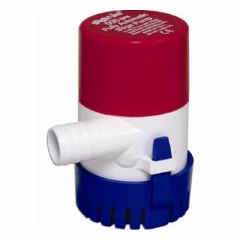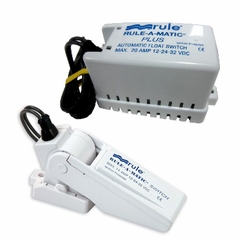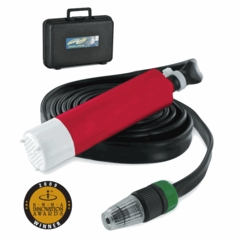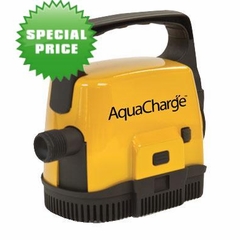Rule Pumps
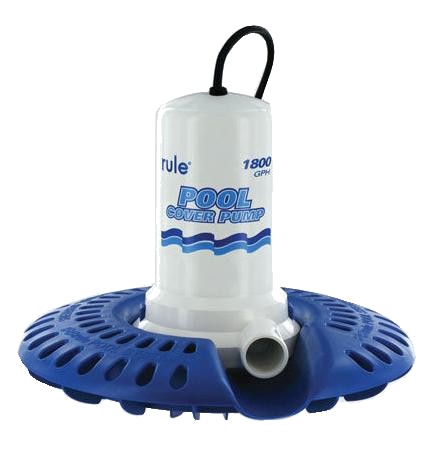
Rule Pumps submersible 12 Volt DC manual or automatic bilge pumps are the industry's standard. The 115 volt automatic computerized sump pumps are used to drain pools, pool covers, basements, garages, utility rooms, sumps, boats and other utility applications.
For the past 35 years Rule Pumps has been known for quality, assurance and phenomenal customer care. Rule submersible Bilge Pumps have set the standard for the industry for decades. They also manufacture computerized home sump pumps and Night Owl battery backup sump pump systems. There are probably few parts of the world where the Rule family of products are not in use and where their brands are not known.
• Rule Pumps Accessories • Rule Technical Data • Rule Pumps Factory LiteratureQuestions & Answers
- What is the purpose of bilge pumps?
- Bilge pumps are designed for small quantities of water and are NOT meant damage control. The American Boat and Yacht Council standards for electric bilge pumps state that they are "intended for control of spray, rain water and normal accumulation of water due to seepage and spillage." Never leave a boat with a known leak alone with an automatic bilge pump in the hope that it will keep your boat afloat. If your boat has a leak, get it fixed or take it out of the water. Don't depend on a pump!
- Are the Rule bilge Pumps self priming?
- Bilge pumps are not Self Priming
- Can the hose run horizontally?
- No....the discharge hose must run continually upwards
- Will increasing the discharge pipe increase output?
- Reductions in hose size will reduce output
- Does reversing polarity decrease pump capacity?
- Reversed polarity runs pump at 20% capacity
- Should I increase the wire gauge on long runs?
- Increase wire gauge for each additional 20 foot run
- Can I install a check valve on the pump discharge?
- Check valves are not recommended
- How do I prevent water from siphoning back?
- Install a vented loop for anti-siphoning
- Do the pumps have a break-in period?
- Break in for 10 hours for maximum pumping
- Does Rule repair the pumps?
- Rule does not repair pumps - it is not cost efficient for the consumer
- Can I get parts for Rule Pumps?
- Rule does not sell pump parts due to liability
- Why doesn't Rule Pumps want check valve on the pump's discharge?
- Check valves are prohibited by the American Boat & Yacht Council for use as an anti-siphon device-and with good reason: They're notorious for failing in both the open and the closed position, which respectively leads to flooding or failure to pump. If the valve is close to the pump, the pump may not be able to overcome the weight of the water on the other side of the valve, rendering the pump ineffective.
-
Why does my automatic Rule Pumps turns off if I install a check valve on the discharge of the pump?
- The automatic bilge pump turns on about every two and a half minutes to "check" for high water. If water causes resistance on the pump, it continues to pump until the resistance lowers. With the check valve installed at the pump, it cant feel the weight of the water, and shuts off, allowing the bilge to fill with water!
- What is the power used by a Rule Computerized Automatic Bilge Pump while in checking mode?
- The power used while the pump is in checking mode is minimal. These pumps operate automatically with no need for an external switch, turning on every 2-1/2 minutes for a approximately 1 (one) second. If the bilge contains water, the pump will sense resistance and will continue to run until no water is present. The computer will then reset itself and the cycle will start again.
- Why does the water drain back into the bilge and re-start my automatic Rule Bilge Pump?
- When the Rule automatic submersibles pump stops, the water in the discharge pipe will drain back into the bilge. If the collection space in the bilge is very small the water level may raise enough to re-start the pump again and again, leading eventually to a dead battery. To avoid this problem, make sure that the bilge collection space is large enough to take the drain-back from the discharge pipe without raising the water level enough to restart the pump. Keep the discharge pipe as short as possible. If you can't avoid the problem, choose a manual pump with a separate switch.
- What are the on/off settings of the Automatic Bilge Pumps 25S, 27S and 53S?
- The automatic pumps will start pumping only if there is 1-3/4" of water and will pump down to 3/4" (timed based operation)
- How to mount a Bilge Pump?
- Your bilge pump should be mounted in the lowest point of the bilge so the pump is at the deepest point and will therefore evacuate the maximum amount of water. Consider where water will collect depending on the angle of the vessel when it is moving and at rest. Where possible the pump should be mounted 2"-3" (50-75mm) from an vertical bulkhead or stringer to avoid possible cavitation or air locks. Your bilge pump needs to be secured to a mounting platform or directly to the vessels hull. Install with correct size screws to ensure you don't penetrate the hull. Water proof sealant can be used to secure the strainer base to the hull if screws are not possible If mounting to the hull is a challenge, install a block secured or bonded to the hull. Mount the pump on a level platform if possible. The pump can be mounted on an angle although the pump will only move water if it is completely submerged in water. If the pump is not mounted upright turn the discharge port to face upwards to prevent the pump air locking. By orientating the port upwards it will allow air to escape from the impeller chamber.
- What are the bilge pump discharge sizes?
- 3/4" Hose 360 - 800 GPH; 1-1/8" Hose 1000 - 2000 GPH ; 1-1/2" Hose 3700 GPH; 2" Hose 4000 GPH; 3" Hose 8000 GPH
- What kind of hose does Rule Pumps recommend to use on the Bilge Pumps?
- Rule Pumps recommends the use of non-collapsible bilge hose to prevent kinking or compressing hose which will prevent water discharge.
- Can I reduce the recommended hose diameter to reduce the flow rate?
- Decreasing the recommended hose diameter will not damage the pump but will reduce the flow rate. The reduction of the flow rate could make the pump cavitate and is not recommended. Reduced hose diameter verses flow rate data is not available.
- How do you install the discharge hose?
- Install the discharge hose in a fashion where the hose will be routed from the port on the bilge pump with a gradual upward incline raising above the thru-hull fitting then dropping back down to the thru-hull fitting. Do not allow the hose to dip or drop anywhere along the hose run, this can cause an air lock. For connecting the hose to the pump use the correct size hose clamp. When securing the hose clamp do not over tighten, this could cause the port to crack. Do not use sealant to secure hose to the pump as this will deteriorate the plastic causing the port to crack. Note: Sailboat discharge hose should rise up above the maximum heeled line to prevent water siphoning back through the bilge pump.
- What is a vented loop?
- The discharge from a bilge can be mounted below the heeled or waterline only if a vented loop is installed to prevent water from siphoning back through the pump flooding the vessel. Proper installation of the vented loop is critical to preventing siphoning. Install the discharge hose in a fashion where the hose will be routed from the port on the bilge pump with a gradual upward incline raising above the thru-hull fitting then dropping back down to the thru-hull fitting. Do not allow the hose to dip or drop anywhere along the hose run, this can cause an air lock. For connecting the hose to the pump use the correct size hose clamp. When securing the hose clamp do not over tighten, this could cause the port to crack. Do not use sealant to secure hose to the pump as this will deteriorate the plastic causing the port to crack. Note: Sailboat discharge hose should rise up above the maximum heeled line to prevent water siphoning back through the bilge pump.
- How do you install a Thru-Hull Fitting?
- Thru-hull fitting should be installed 12" above the water line to prevent water siphoning back through bilge pump. If a thru-hull fitting is installed in the transom of the boat mount the fitting high enough to prevent submergence under any conditions. The discharge from a bilge can be mounted below the heeled or waterline only if a vented loop is installed to prevent water from siphoning back through the pump and flooding the vessel. Proper installation of vented loop is critical to preventing siphoning. It is not necessary to install a vented loop unless thru-hull discharge is below heeled or waterline. Or unless water siphoning back through the pump is occurring.
- How do you install two pumps on a single Thru-Hull fitting?
- To install two pumps with one thru-hull fitting installation is critical. Both discharge hoses need to rise upwards as explained in Hose Installation. The two discharge hoses must rise up to the highest point possible then bend to slope down towards the thru-hull fitting. The two hoses need to merge together into a Y-Valve, a Tee fitting is not recommended. Then the single discharge hose coming off Y-Valve can be routed downwards to the thru-hull fitting. Installation in this way allows water to drain downwards to the thru-hull and not to have the ability to flow back through the other pump.
- How to install a float switch in a boat?
- It is recommended you mount the float switch on a level platform although the float switch can be mounted up to a 15 degree angle. Note: Model 40 Float Switch if mounting fore and aft centerline of vessel, point wires to exit towards the stern.
- How to wire a pump float switch directly to a battery?
- Connect the Brown (Positive) wire from the pump to one Gray wire from Float Switch. Connect the other Gray wire from the Float Switch directly to Positive power supply (Fuse Protected). The Black (Negative) wire from the Bilge pump connects to the Negative battery terminal or Negative buss bar. Wire the pump directly to the power supply, this will ensure the pump has power if the power system on boat has been isolated.
- How to wire a pump float switch to a two position panel switch?
- One Gray wire from the float switch connects to the solid Brown (Positive) wire from Non-Automatic Bilge Pump. The Third wire needs to be connected and run directly to the two position Panel Switch. The other Gray wire should be connected directly to the Positive power supply (Fuse Protected). Connect the Black (Negative) wire to the Negative battery terminal or buss bar. Wire the Bilge pump directly to the power supply, this will ensure the pump has power if the power system on boat has been isolated.
- How to wire a pump float switch to a three position panel switch?
- One Gray wire from the Float Switch connects to the solid Brown (Positive) wire from Non-Automatic Bilge Pump. The third wire should to be connected directly to Manual side of Panel Switch. The other Gray wire from the Float Switch connects directly to the Automatic side of Panel Switch. Connect the Black (Negative) wire to Negative battery terminal or buss bar. Wire the Bilge pump directly to power supply, this will ensure that pump has power if the power system on boat has been isolated.
- What Size Fuse Do I Use with a Bilge Pump?
- For the 360 GPH and 500 GPH 12 volt pumps use a 2.5 amp fuse; for the 700 GPH, 800 GPH and 1000 GPH pumps use a 5 amp fuse; the 1100 GPH pumps use a 6 amp fuse; for the 1500 GPH pumps use a 10 amp fuse; for the 2000 GPH pumps use a 15 amp fuse; ; for the 3700 GPH and 4000 GPH pumps use a 25 amp fuse; ; for the 8000 GPH pumps use two 25 amp fuses
- What Wire Do I Use with Bilge Pumps?
- Rule pumps 360 GPH - 2000 GPH require 16 gauge wire up to 20', increase wire gauge for each additional 20'. Rule pumps 3700 GPH - 8000 GPH require 14 gauge wire up to 20', increase wire gauge for each additional 20'.
- Bilge Pump just installed and is not working?
- Confirm fuse was installed into fuse holder. Check to see if the fuse is blown. Confirm the voltage at the pump through the wiring connections with a Volt Meter to confirm the pump is getting enough power. Confirm the installation uses the correct size wiring.
- Bilge Pump does not run?
- Check wire connection integrity . Check that connections are not corroded. A slight pull on each wire will indicate if wires are still connected. Check to sure no wire joints are hanging down into the water. Verify fuse is not blown. Verify correct fuse size, (it is printed on the side of the bilge pump. If fuse size is correct, check impeller through the inlet opening to be sure it is not jammed or stuck with debris.
- Bilge Pump only runs for a few seconds?
- Insufficient water: The automatic system tests for water approximately every few minutes. If the water level detected is only about 3/4", the pump will shut off after a few seconds. Every few minutes thereafter, it will automatically check the water level and will only continue pumping if sufficient water is present. Clogged strainer or jammed impeller: Disconnect pump from the power source and remove strainer , Remove debris from the strainer and surrounding area. Remove any debris from the impeller. Blocked discharge line: Disconnect pump from the power source and remove blockage from pipes/hoses and discharge port.
- Bilge Pump runs but no water is pumped?
- When the bilge pump is operating but no water is being discharged this is typically caused by an air lock. An air lock occurs when air is trapped in the impeller chamber; centrifugal pumps by nature will only move water (not air) and do not have the ability to self-prime. Do not install a check valve on the pump discharge. Air can trap in the discharge hose if a check valve is installed. A dip or drop in the discharge hose can create an air lock which will prevent the pump moving water. Inspect and reposition discharge hose for a short vertical discharge. Install pump below water line to insure sufficient water flow. Pump strainer and impeller area can be clogged with debris. Disconnect pump from strainer and wiring and clean debris around strainer and impeller, reattach strainer and re-hook wiring.
- Bilge Pump has flow or reduced flow?
- Pump must be wired with correct polarity otherwise the pump will operate in reverse rotation which will reduce flow to less than half volume. Brown Wire - positive, automatic feature for Computerized Automatic and Rule-Mate Pumps. Brown/White Wire - positive, manual override feature. Red Wire - positive, manual feature for Computerized Automatic and Rule-Mate Pumps. Black Wire - negative
- Why does the Rule Bilge Pump operate in manual but not in automatic?
- Low supply voltage is preventing the pump activating in sensing mode. Confirm the voltage at the panel switch with a voltage meter. If automatic side of panel switch isn't putting out DC current then the panel switch needs to be replaced. Circuit board has failed, this is a non-serviceable component.
- Why doesn't the Bilge Pump shut off"?
- The float switch may be stuck in the up position: Check for debris, dirt, fuel or oil residue from bilge water. The float switch is in the down position: The mercury capsule may be stuck in the on position. Tapping on the float may free it, or if needed replace float switch. Wire connections may be incorrect. Automatic pumps may have faulty circuit. Possible electrical short
- Bilge Pump repeatedly blows fuse?
- Incorrect fuse size - install correct fuse. If you are using a circuit breaker - worn/old breaker, replace breaker. Clogged impeller - remove blockage, debris, clean fuel or oil residue. Voltage drop creating higher current draw - increase wire size to heavier wire as suggested on wire chart. Wiring has short either caused by a cut or scrape in the insulation. Pump motor is worn, faulty or has water intrusion - replace pump.
- Which is the replacement strainer for my pump?
- Model 275 - 360 to 1100GPH; Model 276 - Gas Resistant Strainer Base for above Models; Model 277 - Square Bilge Pump; Model 278 - Round Bilge Pumps,1500 to 2000 GPH; Model 279 - Round Bilge Pumps,2800 to 3700 GPH; Model 285 Rule Mate Bilge Pumps, 500 to 1100 GPH; Model 286 Rule Mate Bilge Pumps, 1500 to 2000 GPH ;
- Why are the Bilge Pump wires overheated and melted?
- Pump motor worn, faulty, water intrusion - replace pump; Incorrect wire size - replace wire with correct wire size; Incorrect fuse size - install correct fuse; If using circuit breaker - worn/old breaker, replace breaker.
- Why is the Bilge Pump shaft corroded?
- Electrolysis, cracked housing: Inspect pump housing for cracks which can cause leakage into motor cavity causing corrosion. It is possible that errant current running through the wiring causing corrosion.
- Bilge Pump impeller spins backwards?
- Pump must be wired with correct polarity otherwise the pump impeller will spin backwards which will reduce flow to less than half volume. Brown Wire - positive- Automatic feature for Computerized Automatic and Rule-Mate Pumps.; Brown/White Wire - positive- Manual override feature; Red Wire - positive- Manual feature for Computerized Automatic and Rule-Mate Pumps; Black Wire - negative
- Do I need a separate switch with automatic Rule Bilge Pumps?
- Through advanced electronic technology, Rule Automatic Bilge Pumps eliminate the need for a separate switch to activate the pump. Once power is supplied, starting and stopping is completely automatic. The pump checks for water every 2-1/2 minutes by running for a second and measuring load against the impeller. If water is present, the pump remains on until the water is removed. Thereafter it resumes its 2-1/2 minute check cycle. The pumps feature two positive leads, one which is automatic and one which can manually override the pump and turn it on at any time.
- How do I mount an automatic Rule Bilge Pumps?
- Press strainer base fingers inward and lift pump to remove from strainer. Mount the strainer to your boat with stainless steel screws. On a fiberglass boat you may prefer to bond a wooden block in place and then mount the strainer. To assemble pump to strainer, align the clasps to the strainer fingers and press pump down to snap lock in place. To mount this pump to a transom or a side surface, use Rule Model 66 vertical mounting bracket.
- What size wire should I use to connect the automatic Rule Bilge Pumps?
- Normal installation requires 16-gauge wire. For installations over 25 feet from battery, use 14-gauge wire.
- How do I connect the automatic Rule Bilge Pumps electrically?
- Black pump wire connects to negative (-) side of the battery. Brown pump wire connects to the automatic side of the switch. Brown with white stripe wire connects to the manual side of the switch.
- On what wire should the fuse be?
- Install recommended size fuse in the positive (+) Brown wire.
- What fuse sizes should I use on 12 volt pumps?
- Model 500 GPH uses 2.5 amps fuse; 800 GPH uses 5.0 amp fuse; 1100 GPH uses 5.0 amp fuse; 2000 GPH 15.0 amp fuse.
- Are the Rule Bilge Pumps equipped with fuses?
- Pump are not equipped with a fuse. Always install the recommended fuse size in the (+) power line. Failure to install proper fuse could result in personal injury and/or fire hazards.
- At what level should wire connections be?
- KEEP ALL WIRE CONNECTIONS ABOVE HIGHEST POSSIBLE WATER LEVEL.
- How do I seal (waterproof) wire connections?
- Wire connections should be sealed with Marine Grade Silicone Rubber, Liquid Electrical Tape, or Sudbury Elastomeric Marine Sealant to prevent corrosion.
- When eliminating the manual override option ( 2-wire installation) what do I do with the 3rd wire (Brown/White)?
- When using two wire installations, eliminating the manual override option, the 3rd wire (Brown/White) must be sealed and secured high above the bilge water?
- How are Rule Pumps plumbed?
- Bilge Pumps must be plumbed to a thru-hull fitting that remains above the water line at all times. On sailboats, locate the thru-hull fitting high enough on the center of the transom to be above the anticipated water line. To prevent water traps that can cause your pump to airlock the hose must rise continuously from the pump to the thru-hull fitting with no clips where water can collect. Attach the discharge hose to the pump and thru-hull fitting with stainless steel hose clamps.



